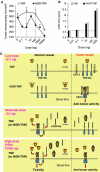Peptide-mediated targeting of cytokines to tumor vasculature: the NGR-hTNF example
- PMID: 23743670
- PMCID: PMC3832761
- DOI: 10.1007/s40259-013-0048-z
Peptide-mediated targeting of cytokines to tumor vasculature: the NGR-hTNF example
Abstract
A growing body of evidence suggests that the efficacy of cytokines in cancer therapy can be increased by targeting strategies based on conjugation with ligands that recognize receptors expressed by tumor cells or elements of the tumor microenvironment, including the tumor vasculature. The targeting approach is generally conceived to permit administration of low, yet pharmacologically active, doses of drugs, thereby avoiding toxic reactions. However, it is becoming clear that, in the case of cytokines, this strategy has another inherent advantage, i.e. the possibility of administering extremely low doses that do not activate systemic counter-regulatory mechanisms, which may limit their potential therapeutic effects. This review is focused on the use of tumor vasculature-homing peptides as vehicles for targeted delivery of cytokines to tumor blood vessel. In particular, we provide an overview of peptide-cytokine conjugates made with peptides containing the NGR, RGD, isoDGR or RGR sequences and describe, in more details, the biological and pharmacological properties of NGR-hTNF, a peptide-tumor necrosis factor-α conjugate that is currently being tested in phase II and III clinical studies. The results of preclinical and clinical studies performed with these products suggest that peptide-mediated vascular-targeting is indeed a viable strategy for delivering bioactive amounts of cytokines to tumor endothelial cells without causing the activation of counter-regulatory mechanisms and toxic reactions.
Figures

Similar articles
-
Defining the optimal biological dose of NGR-hTNF, a selective vascular targeting agent, in advanced solid tumours.Eur J Cancer. 2010 Jan;46(1):198-206. doi: 10.1016/j.ejca.2009.10.005. Eur J Cancer. 2010. PMID: 19900802 Clinical Trial.
-
NGR-based strategies for targeting delivery of chemotherapeutics to tumor vasculature.Anticancer Agents Med Chem. 2012 Mar;12(3):239-46. doi: 10.2174/187152012800228751. Anticancer Agents Med Chem. 2012. PMID: 22263803 Review.
-
Phase II study of NGR-hTNF, a selective vascular targeting agent, in patients with metastatic colorectal cancer after failure of standard therapy.Eur J Cancer. 2010 Oct;46(15):2746-52. doi: 10.1016/j.ejca.2010.07.012. Epub 2010 Aug 12. Eur J Cancer. 2010. PMID: 20708923 Clinical Trial.
-
Mechanism of Action of the Tumor Vessel Targeting Agent NGR-hTNF: Role of Both NGR Peptide and hTNF in Cell Binding and Signaling.Int J Mol Sci. 2019 Sep 12;20(18):4511. doi: 10.3390/ijms20184511. Int J Mol Sci. 2019. PMID: 31547231 Free PMC article.
-
Tumor vasculature targeting through NGR peptide-based drug delivery systems.Curr Pharm Biotechnol. 2011 Aug;12(8):1128-34. doi: 10.2174/138920111796117373. Curr Pharm Biotechnol. 2011. PMID: 21470145 Review.
Cited by
-
Radiation synergizes with antitumor activity of CD13-targeted tissue factor in a HT1080 xenograft model of human soft tissue sarcoma.PLoS One. 2020 Feb 21;15(2):e0229271. doi: 10.1371/journal.pone.0229271. eCollection 2020. PLoS One. 2020. PMID: 32084238 Free PMC article.
-
Targeting Tissue Factor to Tumor Vasculature to Induce Tumor Infarction.Cancers (Basel). 2021 Jun 7;13(11):2841. doi: 10.3390/cancers13112841. Cancers (Basel). 2021. PMID: 34200318 Free PMC article. Review.
-
Glycine N-methylation in NGR-Tagged Nanocarriers Prevents Isoaspartate formation and Integrin Binding without Impairing CD13 Recognition and Tumor Homing.Adv Funct Mater. 2017 Sep 26;27(36):1701245. doi: 10.1002/adfm.201701245. Adv Funct Mater. 2017. PMID: 28979182 Free PMC article.
-
Chromogranin A and its fragments in cardiovascular, immunometabolic, and cancer regulation.Ann N Y Acad Sci. 2019 Nov;1455(1):34-58. doi: 10.1111/nyas.14249. Epub 2019 Oct 6. Ann N Y Acad Sci. 2019. PMID: 31588572 Free PMC article. Review.
-
Developing Actively Targeted Nanoparticles to Fight Cancer: Focus on Italian Research.Pharmaceutics. 2021 Sep 22;13(10):1538. doi: 10.3390/pharmaceutics13101538. Pharmaceutics. 2021. PMID: 34683830 Free PMC article. Review.
References
-
- Pasche N, Neri D. Immunocytokines: a novel class of potent armed antibodies. Drug Discov Today. 2012;17(11–12):583–590. - PubMed
-
- Kontermann RE. Antibody-cytokine fusion proteins. Arch Biochem Biophys. 2012;526(2):194–205. - PubMed
-
- Arap W, Pasqualini R, Ruoslahti E. Cancer treatment by targeted drug delivery to tumor vasculature in a mouse model. Science. 1998;279(5349):377–380. - PubMed
Publication types
MeSH terms
Substances
LinkOut - more resources
Full Text Sources
Other Literature Sources
Medical

